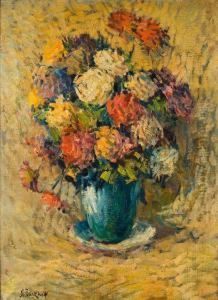Nicolaj Tarkoff Paintings
Nicolaj Tarkoff, born in Moscow, Russia, in 1871, was a painter known for his vibrant use of color and unique blend of influences that spanned Russian folk art, French Impressionism, and elements of Fauvism. His artistic journey began in a culturally rich environment that was rapidly embracing the changes of the modern world. Tarkoff's early exposure to the artistic traditions of his homeland and his fascination with the burgeoning art scenes across Europe played a crucial role in shaping his distinctive style.
Tarkoff's move to Paris in the late 19th century marked a significant turning point in his career. Immersing himself in the city's avant-garde circles, he befriended influential artists and writers, absorbing the revolutionary ideas that permeated the Parisian art world. His work from this period reflects a bold experimentation with color and form, as he sought to capture the essence of his subjects through a deeply personal lens. Despite his connections to prominent movements of the time, Tarkoff maintained a unique identity, never fully aligning himself with any single group.
Throughout his career, Tarkoff exhibited his work in various European cities, gaining recognition for his contributions to modern art. His paintings often depicted landscapes, still lifes, and scenes from daily life, rendered in a palette that could range from softly harmonious to strikingly vivid. The emotional depth and intensity of Tarkoff's work resonated with audiences and critics alike, earning him a place among the notable artists of his era.
Nicolaj Tarkoff's legacy is that of an artist who bridged the worlds of his Russian heritage and the avant-garde movements of early 20th-century France. His death in 1930 marked the end of a career that had spanned several decades of dynamic change in the art world. Today, Tarkoff's paintings are celebrated for their innovative use of color and their ability to evoke a profound sense of mood and atmosphere, securing his reputation as a significant figure in the development of modern art.
